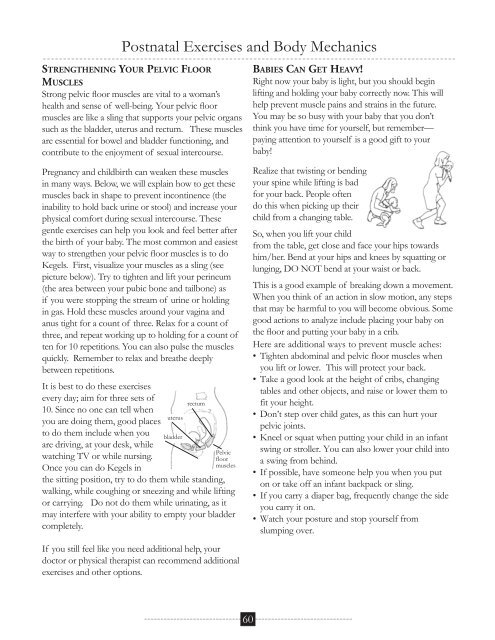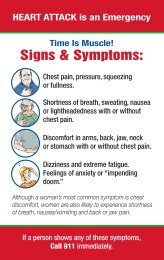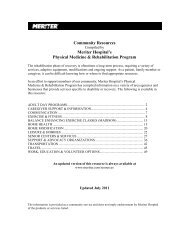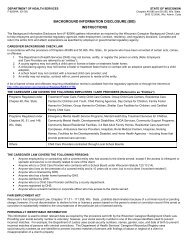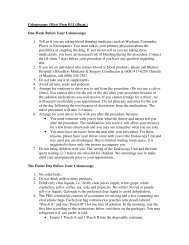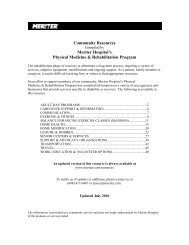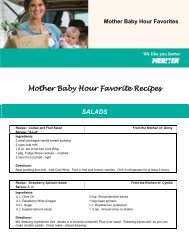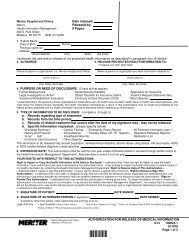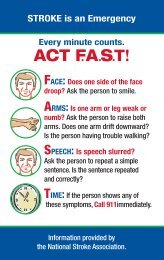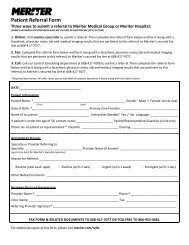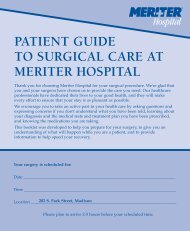A Guide To Your New Family's First Weeks - Meriter Health Services
A Guide To Your New Family's First Weeks - Meriter Health Services
A Guide To Your New Family's First Weeks - Meriter Health Services
Create successful ePaper yourself
Turn your PDF publications into a flip-book with our unique Google optimized e-Paper software.
Strengthening <strong>Your</strong> Pelvic Floor<br />
Muscles<br />
Strong pelvic floor muscles are vital to a woman’s<br />
health and sense of well-being. <strong>Your</strong> pelvic floor<br />
muscles are like a sling that supports your pelvic organs<br />
such as the bladder, uterus and rectum. These muscles<br />
are essential for bowel and bladder functioning, and<br />
contribute to the enjoyment of sexual intercourse.<br />
Pregnancy and childbirth can weaken these muscles<br />
in many ways. Below, we will explain how to get these<br />
muscles back in shape to prevent incontinence (the<br />
inability to hold back urine or stool) and increase your<br />
physical comfort during sexual intercourse. These<br />
gentle exercises can help you look and feel better after<br />
the birth of your baby. The most common and easiest<br />
way to strengthen your pelvic floor muscles is to do<br />
Kegels. <strong>First</strong>, visualize your muscles as a sling (see<br />
picture below). Try to tighten and lift your perineum<br />
(the area between your pubic bone and tailbone) as<br />
if you were stopping the stream of urine or holding<br />
in gas. Hold these muscles around your vagina and<br />
anus tight for a count of three. Relax for a count of<br />
three, and repeat working up to holding for a count of<br />
ten for 10 repetitions. You can also pulse the muscles<br />
quickly. Remember to relax and breathe deeply<br />
between repetitions.<br />
It is best to do these exercises<br />
every day; aim for three sets of<br />
10. Since no one can tell when<br />
you are doing them, good places<br />
to do them include when you<br />
are driving, at your desk, while<br />
watching TV or while nursing.<br />
Once you can do Kegels in<br />
Postnatal Exercises and Body Mechanics<br />
uterus<br />
bladder<br />
rectum<br />
Pelvic<br />
floor<br />
muscles<br />
the sitting position, try to do them while standing,<br />
walking, while coughing or sneezing and while lifting<br />
or carrying. Do not do them while urinating, as it<br />
may interfere with your ability to empty your bladder<br />
completely.<br />
If you still feel like you need additional help, your<br />
doctor or physical therapist can recommend additional<br />
exercises and other options.<br />
Babies Can Get Heavy!<br />
Right now your baby is light, but you should begin<br />
lifting and holding your baby correctly now. This will<br />
help prevent muscle pains and strains in the future.<br />
You may be so busy with your baby that you don’t<br />
think you have time for yourself, but remember—<br />
paying attention to yourself is a good gift to your<br />
baby!<br />
Realize that twisting or bending<br />
your spine while lifting is bad<br />
for your back. People often<br />
do this when picking up their<br />
child from a changing table.<br />
So, when you lift your child<br />
from the table, get close and face your hips towards<br />
him/her. Bend at your hips and knees by squatting or<br />
lunging, DO NOT bend at your waist or back.<br />
This is a good example of breaking down a movement.<br />
When you think of an action in slow motion, any steps<br />
that may be harmful to you will become obvious. Some<br />
good actions to analyze include placing your baby on<br />
the floor and putting your baby in a crib.<br />
Here are additional ways to prevent muscle aches:<br />
• Tighten abdominal and pelvic floor muscles when<br />
you lift or lower. This will protect your back.<br />
• Take a good look at the height of cribs, changing<br />
tables and other objects, and raise or lower them to<br />
fit your height.<br />
• Don’t step over child gates, as this can hurt your<br />
pelvic joints.<br />
• Kneel or squat when putting your child in an infant<br />
swing or stroller. You can also lower your child into<br />
a swing from behind.<br />
• If possible, have someone help you when you put<br />
on or take off an infant backpack or sling.<br />
• If you carry a diaper bag, frequently change the side<br />
you carry it on.<br />
• Watch your posture and stop yourself from<br />
slumping over.<br />
60


